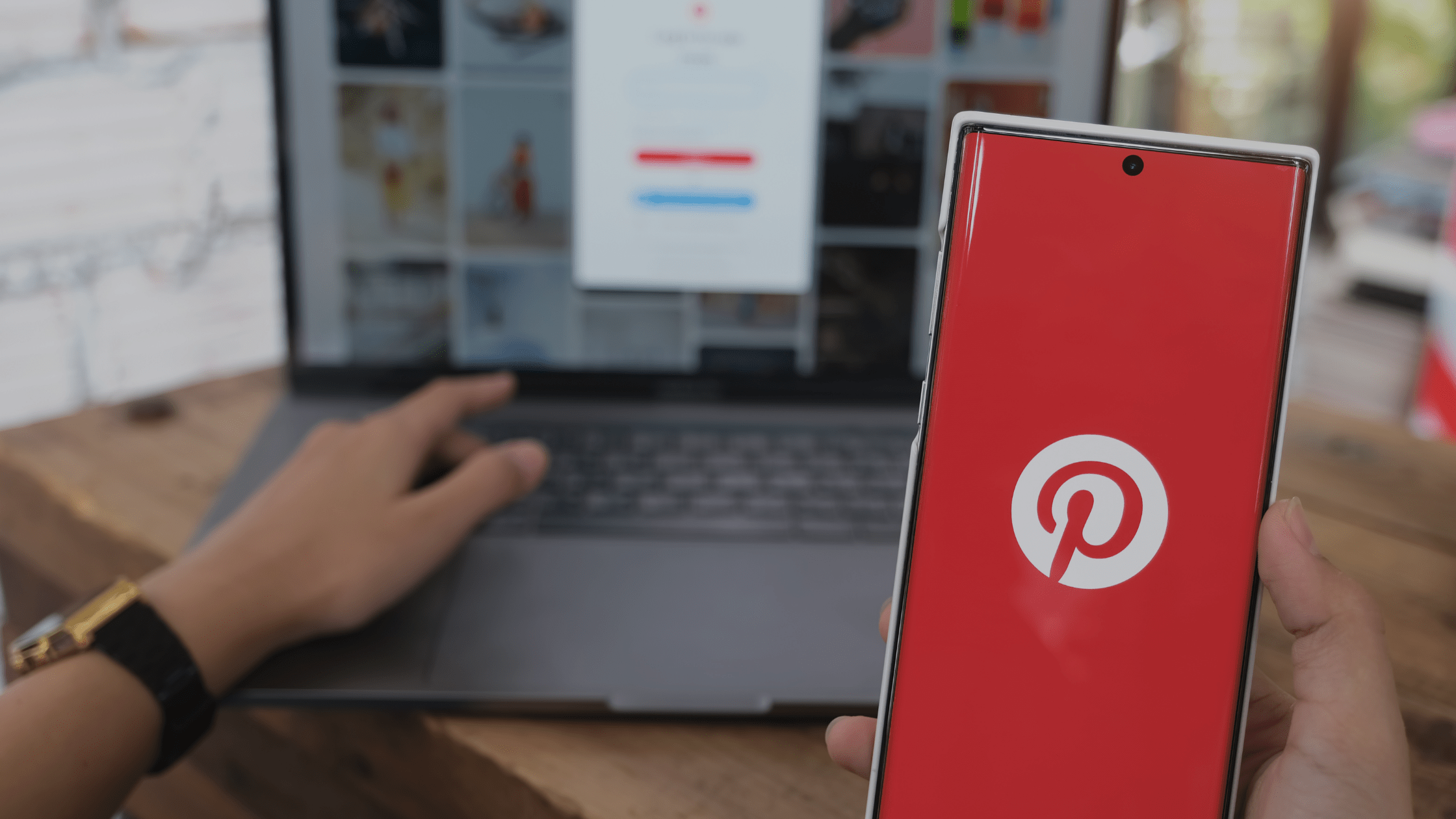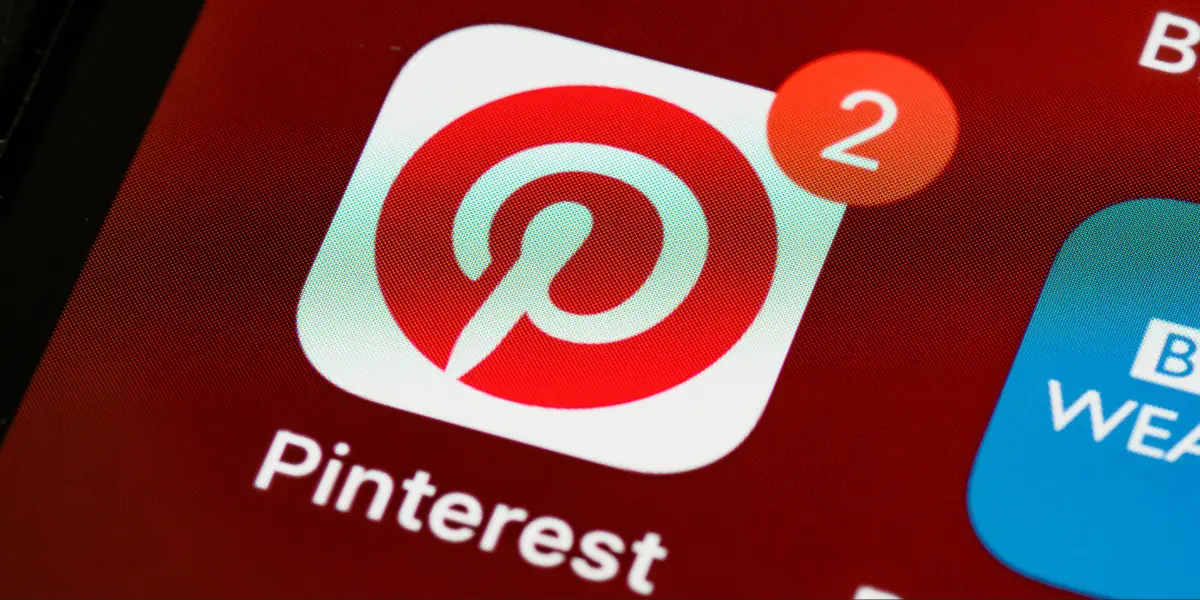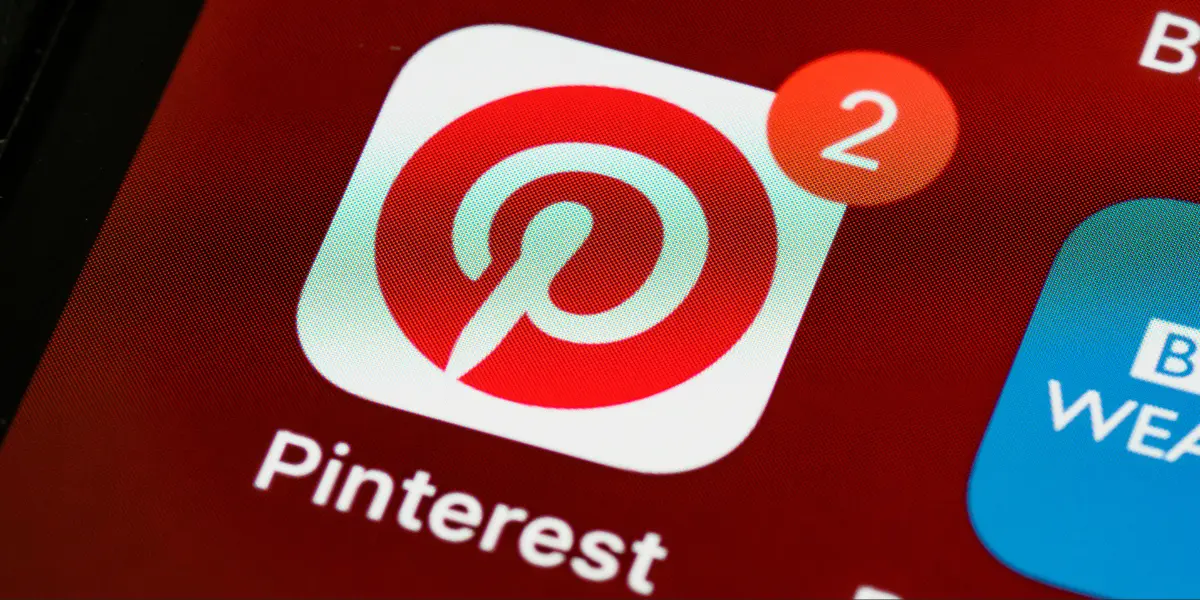Welcome to the Giraffe Guide to Pinterest Marketing. Here, you’ll learn how the popular visual discovery platform that has transformed the way people find inspiration, ideas, and products online, works for brands.
At Giraffe, we have plenty of experience in using Pinterest to help our clients sell more products and reach a new audience, so we’re here to walk you through the platform’s features, benefits, best practices, and how to leverage both organic and paid strategies to maximize your success.
What is Pinterest?
Pinterest is a social media platform that was founded in March 2010, and allows users to discover, save, and organize ideas through visual content known as “pins.” It operates as a virtual moodboard, enabling users to curate collections of images, videos, and articles.
As of July 2023, Pinterest is currently sitting at 450 million monthly users, and that number looks as though it’s set to rise. In fact, it’s seen a regular 7.5% rise in users, making it the third fastest growing social media platform today, beaten only by Snapchat and LinkedIn.
Benefits of Using Pinterest
Pinterest is a little different to other social media platforms, in that the social aspect takes a bit of a back seat. Users are encouraged to share and save content that resonates with them, building up moodboards of everything they enjoy.
But that doesn’t mean there’s no benefit for brands! From brand exposure to ecommerce potential, there’s plenty that brands and businesses can gain from using Pinterest. Below, we’ve outlined four of the biggest benefits to using Pinterest as a business:
- Visual Discovery: Pinterest is renowned for its visual appeal and ability to inspire users by presenting a vast array of captivating images and videos. Whether you’re seeking home decor ideas, recipe inspiration, or fashion trends, Pinterest’s visually rich content helps you discover new ideas and possibilities. If your brand has access to high-quality and stunning images, you’re missing out by not publishing them on Pinterest!
- Brand Exposure: For businesses, Pinterest provides an excellent opportunity to showcase products and services to a broad audience. By creating compelling and visually appealing pins, businesses can drive traffic to their websites, increase brand visibility, and attract potential customers.
- E-commerce Potential: Pinterest has recognized the power of its platform for e-commerce. With shopping features seamlessly integrated into pins, users can click on a product image and be directed to the website where they can make a purchase. This makes Pinterest a valuable sales channel for businesses looking to capitalize on the platform’s vast user base.
- Longevity of Pins: Unlike other social media platforms where content can quickly get buried in the feed, pins on Pinterest have a longer lifespan. Due to the platform’s searchability and organizational structure, pins can continue to generate traffic and engagement months or even years after being posted. This longevity makes Pinterest a valuable platform for evergreen content.
As you can see, there’s plenty of benefit to be had in making Pinterest a part of your brand’s marketing strategy! And now that you know what it’ll bring to the table, it’s time to see how to get up and running with Pinterest!
Getting Started with Pinterest Marketing
Luckily for us, getting started with Pinterest is super easy! There are only two types of account, but for the purposes of using it as a brand, you’ll need a business one.
We go into this in much more detail below!
Account Setup
To start generating Pinterest traffic, you’ll need to create a Pinterest business account. This will give you access to features that are not available on personal accounts, including account analytics, pin scheduling, and more.
Once you’ve created your business account, you should optimise your account by adding a profile image, account bio, and a link to your website. Your bio should include keywords that describe your business and the products or services you offer.
Remember, it’s important, like on any other platform, not to just stuff your bio with keywords that you think will be searched for. Take the time to write out an accurate bio with appropriate keywords.
Navigating the Interface
Pinterest offers a user-friendly interface that allows you to easily navigate and discover inspiring content. Here’s a closer look at the key elements of the Pinterest interface:
- Home Feed: The home feed is the first screen you see upon logging into Pinterest. It presents a personalized collection of pins from accounts and topics you follow. The home feed is designed to showcase content that aligns with your interests and preferences. As you engage with pins by saving or clicking on them, Pinterest’s algorithm learns your preferences and tailors the content displayed in your feed accordingly.
- Search Functionality: Pinterest’s search bar is located at the top of the interface, allowing you to explore keywords, topics, or specific pin types to find relevant content. When you enter a search term, Pinterest provides suggested search terms and displays related topics to help you refine your search. You can also use filters to narrow down your results by category, topic, or other criteria.
- Pins and Boards: Pins are the core units of content on Pinterest. Each pin represents an image, video, or article that users can save, organize, and share. When you click on a pin, it expands to display more details, including the source URL, description, and options to save, like, or comment on the pin. Boards, on the other hand, are virtual collections that allow you to organize and categorize your saved pins based on themes or topics. You can create multiple boards and customize them with titles, descriptions, and cover images.
- Related Pins and Recommendations: As you interact with pins and boards, Pinterest provides related pins and recommendations based on your activity and interests. These suggestions appear on the interface, guiding you to discover more content that aligns with your preferences. It’s an excellent way to explore new ideas and find inspiration beyond your immediate feed.
- Notifications: The notification tab alerts you to new activity related to your account, such as comments, likes, and followers. It also notifies you when someone repins or saves your content. Staying updated with notifications allows you to engage with other users, respond to comments, and foster a sense of community on Pinterest.
- Account Settings: Accessible from your profile, the account settings allow you to manage your profile information, privacy settings, email notifications, and connected social media accounts. You can also access analytics to gain insights into the performance of your pins and boards – this is vital if you’re a brand using the platform.
Pinterest’s intuitive interface makes it easy to navigate and discover content that resonates with your interests. By utilizing the search functionality, engaging with pins and boards, and exploring the recommendations, you can uncover a world of inspiration and tailor your Pinterest experience to suit your preferences.
An Organic Approach to Pinterest Marketing
For a business just dipping its toes into the world of Pinterest marketing, an organic strategy is most likely the best approach, especially as its just learning the ropes.
If that’s you, organic Pinterest marketing, whilst not as powerful as paid, still has a lot of potential when it comes to reaching new people and growing your brand.
We’ll go into best practices later in the guide, but when thinking about content creation for Pinterest, here are a few things to keep in mind:
- Visual Appeal: Emphasize high-quality, eye-catching visuals that align with your brand.
- Pin Types: Experiment with different pin types, including static images, videos, carousels, and story pins.
- Pin Descriptions: Craft keyword-rich, compelling descriptions that provide context and encourage engagement.
- Rich Pins: Implement rich pins to add additional information, such as product details or recipe ingredients. Learn more about rich pins here.
Paid Pinterest Marketing
Alongside an organic strategy, you also, like every other social media platform, have the option to put money behind your efforts to reach a new audience. In this section, we’ll look at paid advertising on Pinterest to see how it works, and how you can make the most of it.
Again, like most other social platforms, you have a plethora of ad types to play with on Pinterest. These include idea pins, try on product pins, collection ads, carousel ads, shopping ads, and finally promoted pins.
Below, we’ve broken down each ad type to explain what they can do for your brand!
Idea Pins
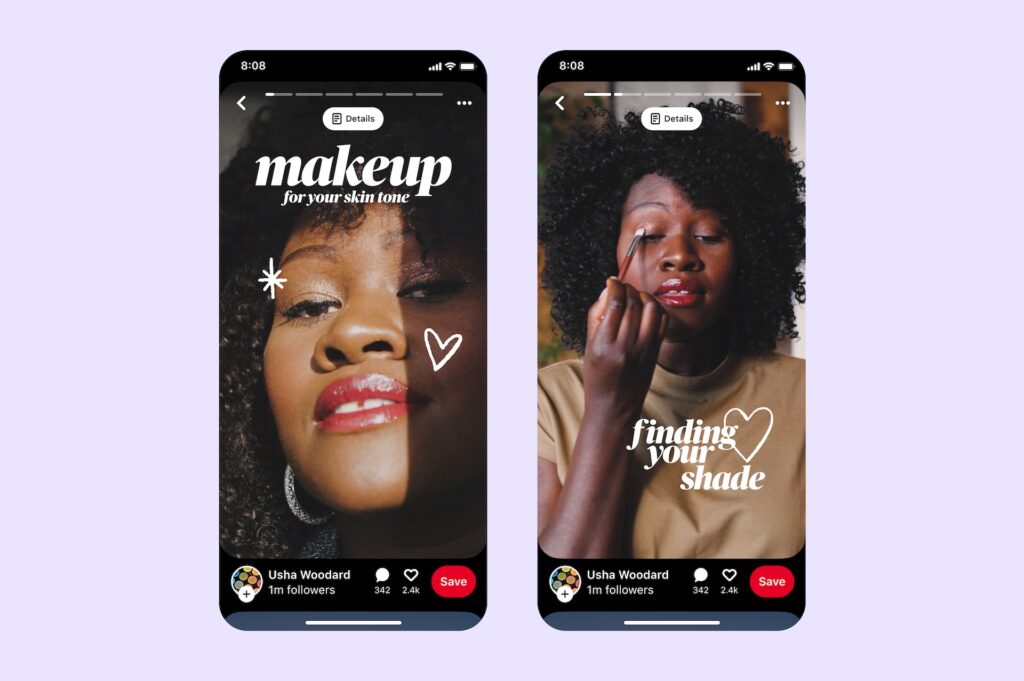
Idea pins are a relatively new introduction to Pinterest, only launching in 2022. They work similarly to stories on Instagram, in that idea pins are comprised of short videos, or a collection of up to twenty graphics, designed to draw attention. Often, these will be used for short form how to videos, product reviews, etc.
This form of pin offers some unique features that others do not. These include:
- Ability to tag users
- Interactive stickers (like IG Stories)
- Text and graphic overlays
- Ability to add voiceovers (like TikTok)
- An in-app creation suite (not essential to use, but helpful)
This isn’t an exhaustive list, but it is the primary features you’ll be likely to use when creating idea pins. For a full rundown, and even more information about this ad type, you can check out Pinterest’s full guide here.
Try On Product Pins
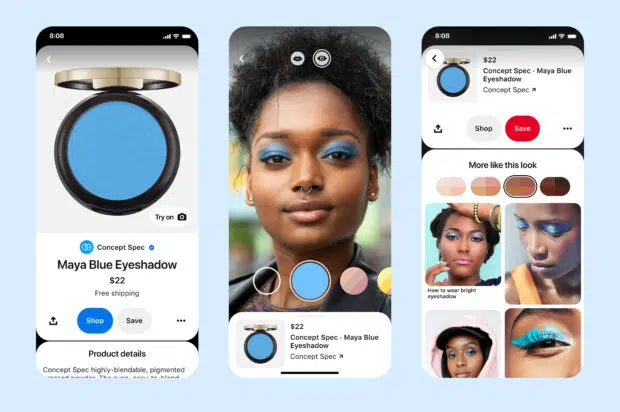
The problem with buying products online is that you can’t really see what they’ll look like when you’re wearing them. This becomes a problem with products like makeup, but it’s also where Pinterest has given us a solution.
Try on Product Pins are an augmented reality “fitting room” in which you can virtually “try on” products before you make a purchase. As you can see from the image above, this is particularly powerful for beauty brands, as it allows potential customers to visualise what the product will look like before they make a purchase.
Cool, right?!
As of right now, these are still in testing – but you can apply to use them for your brand here.
Collection Ads
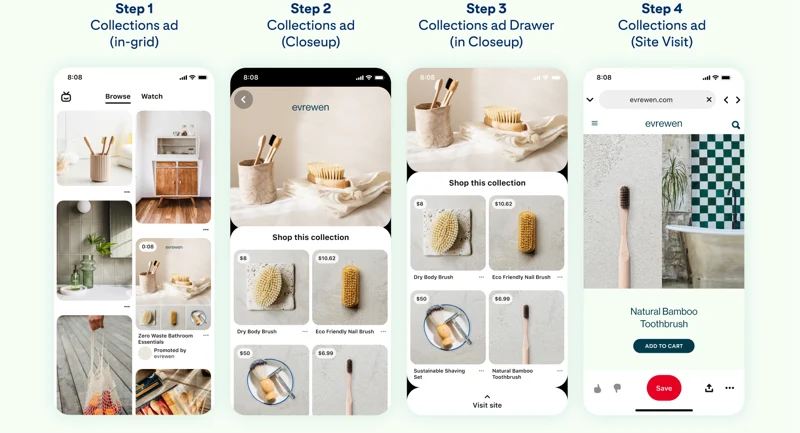
Collection ads are just what the name implies – a collection of images that a user is able to scroll through.
These consist of one main cover image (or video) along with three supporting images. These can then be tapped to open up a larger collection of up to 24 different images.
The rub here is that collection ads will only display on mobile, and will not appear on the desktop version of Pinterest at all. However, seeing that 82% of all Pinterest traffic comes from the mobile app, this shouldn’t be a problem for your reach.
You don’t need us to tell you that any brand with stunning, high-quality images and videos would make excellent use of collection ads. And the best bit? They can be made automatically, with related images being pulled directly from existing catalogues!
Carousel Ads
Carousel ads will display in the home feed exactly like regular pins. However, the key difference is that users will be able to scroll through images or videos within the carousel, exactly the same way that carousels work on Instagram.
Keep in mind that you’re limited to using 2-5 images/videos per carousel, so it’s perfect for showing off either multiple angles or aspects of the same product, or showing a collection of related products.
Shopping Ads
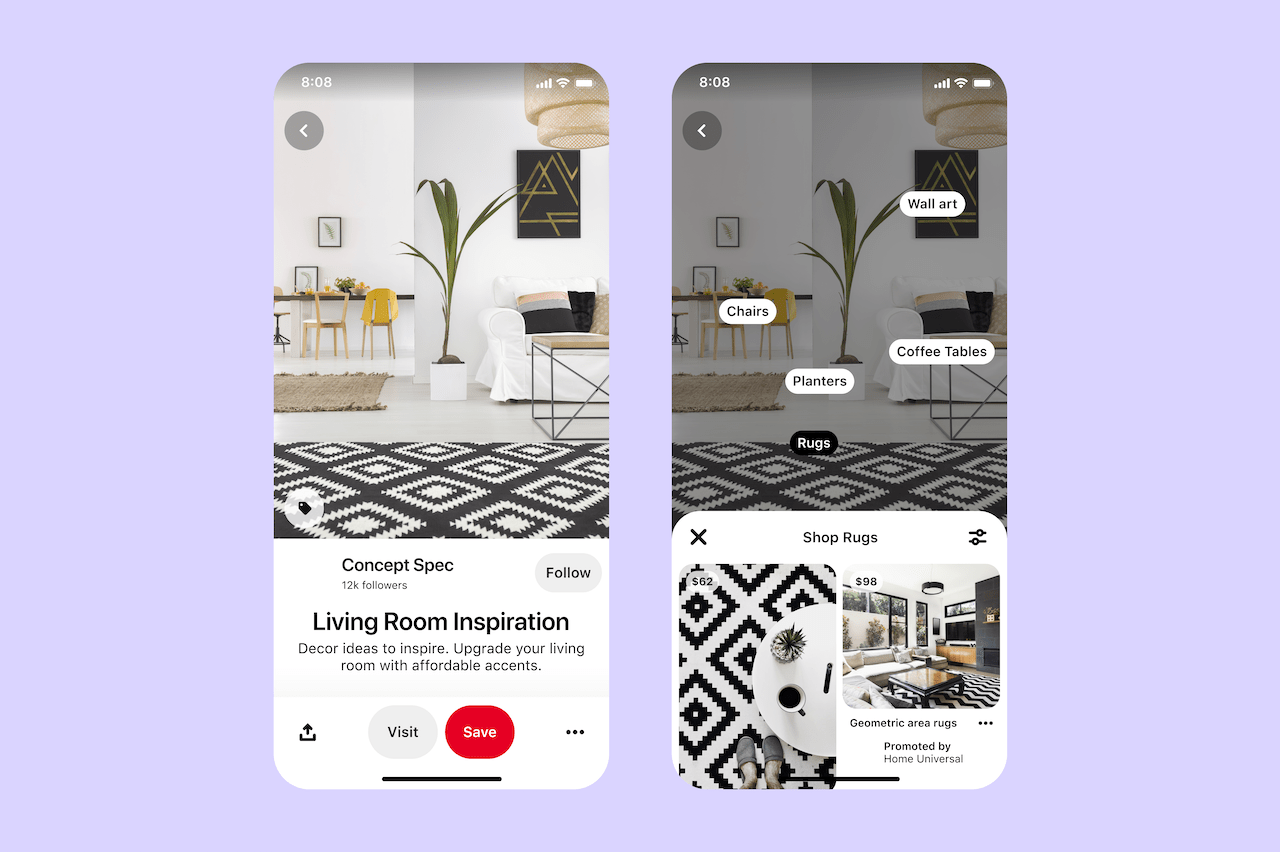
These ads, unlike collection or carousel ads, will only feature one image or video, and will pull directly from your existing catalogue (see Setting up a Pinterest Shop below for more information on that).
Another benefit of this form of ad is that you’re able to tag products, allowing users to tap on your tag to see the product listing within Pinterest. Using this method, you’re able to showcase multiple products (see image above).
Promoted Pins
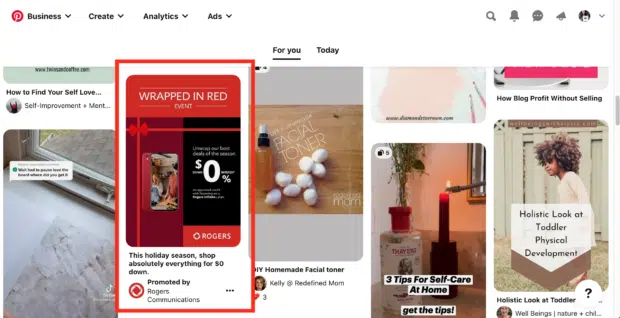
We’ve left these for last because they’re the simplest form of ad that Pinterest has to offer. Much like sponsored posts on platforms like Facebook and Instagram, you’re essentially putting money behind an existing pin to “boost” it.
They’re comprised of a single image or video, with the only identifier being the “Promoted by” text below your chosen creative.
By promoting, or “boosting,” a Pin, you’re able to put it in front of new people, outside of your existing follower base – extremely helpful if you’re looking to grow your Pinterest audience.
Setting up a Pinterest Shop
A couple of the ad types above mentioned a product catalogue in which images and videos are pulled from.
On Pinterest, a catalogue is essentially a collection of your brand’s products that can either be created directly on the platform, or imported from services like WooCommerce or Shopify.
If you go down the importing route, changes will sync up. So, whenever you edit a product in your catalogue (in Shopify or WooCommerce) the changes will appear within the catalogue in Pinterest. It’s because of this that the import option is likely the best bet.
We won’t go into details about how to set up a Pinterest catalogue here, however, a rough outline looks like this:
- Create a Pinterest Business account
- Either connect your existing storefront, or manually add products
- Join the Verified Merchant Programme to help you build your brand
- Set up your ads
It’s as simple as that! For a full breakdown of how to do the above, we highly recommend you check out Pinterest’s various resources on shopping here.
Analytics and Optimization
Much like any other social media platform, you need to make use of the analytics and data available to you. We won’t dive too deep into the the world of content optimising on Pinterest, but the below is a good overview if you’re just getting started with Pinterest marketing!
What Data is Available?
The Pinterest analytics dashboard, like other social media platforms, offers a host of different data you can play with. To have a successful social media strategy, it’s important that you’re regularly analysing this data, using it to influence the content you’re making on a daily, weekly, or monthly basis.
The analytics can be split into two sections, which are Overview and In-Depth. Keep reading to see a breakdown of each, and how you should use them!
The Overview Data
This level of data includes overall profile performance, your account’s top pins, as well as insights into your audience, and much more. These metrics are designed to give you an at-a-glance look at your brand’s performance on Pinterest. Check out a breakdown of each:
- Profile Performance: Monitor your profile’s growth, including the number of monthly viewers, engagements, and followers. Track changes over time to evaluate the effectiveness of your content strategy.
- Top Pins: Identify which of your pins are performing exceptionally well in terms of impressions, saves, and clicks. Understanding what content resonates with your audience can guide your future pin creation.
- Audience Insights: Gain valuable insights into your audience demographics, interests, and locations. Use this information to tailor your content to suit your target audience’s preferences.
The In-Depth Data
These analytics aren’t concerned with the big picture, but rather let you get much more granular, diving deep into individual pins to see how they performed. It’s these metrics that you should be making use of when fine-tuning your Pinterest content. The three primary data sources you’ll find here are…
- Click-Through Rate (CTR): Measure the CTR for each pin, which indicates how many users clicked on your pin to visit your website. Pins with high CTRs indicate compelling content and can guide your future content creation.
- Engagement Metrics: Analyse the number of saves, comments, and likes for each pin. Pins with higher engagement rates indicate content that resonates with your audience.
- Conversion Tracking: If you’ve set up conversion tracking, you can measure how many users took desired actions, such as completing a purchase or signing up for a newsletter, after clicking on your pins. This data can help you understand the effectiveness of your Pinterest content in driving conversions.
Best Practices for Pinterest Marketing
We’ve spoken a lot about the analytics side of Pinterest, but there’s a good chance that, if you’re new to the platform, you just want to know the essentials. How can you grow an audience? How can you make sales?
Well, in this section, we’re going to look at the best practices that you NEED to be being mindful of when creating content and interacting with other users on Pinterest.
Create a Consistent Brand Identity
Your brand needs to be visually and tonally consistent across the Internet. Your website should feel holistically connected to your social content, which should in turn match the feeling of your physical products.
Basically, social media is just like any other part of your brand: It needs to be in-sync with everything else, becoming part of a unified whole. And because Pinterest is such a visual platform, how your brand looks is one of the most important things you should be paying attention to.
So, when creating content for Pinterest, make sure the colours, fonts, elements, icons, photography, and everything else matches your overall brand aesthetic. This is the same for your tone of voice too. If you’re professional on your website and other social platforms, be professional on Pinterest too.
Understand Your Target Audience
We spoke about using analytics to understand your audience in the section above, but that’s so important we’d like to reiterate it.
If you’re not creating content with your target audience in mind, you’re not going to succeed on Pinterest. Heck, you’re not going to succeed on any social media platform.
You need to be making constant use of the data available to you through Pinterest analytics. Trust us when we say, this data is by far the most valuable tool you have at your disposal when it comes to Pinterest marketing.
Optimize for Search
All social media platforms essentially function as search engines. As a side note, did you know that 40% of all Gen Z use TikTok to search, rather than traditional tools like Google or Bing? This search functionality is present on all social platforms, including Pinterest.
What does this mean for you?
Well, it means you need to be smart about the captions you’re writing for your Pinterest content. You need to accurately fill out titles, descriptions, and board names to include the various keywords that your target audience is searching for.
This can include single words, like “design,” “marketing,” “interiors,” etc, or they can include what’s known as long-tail keywords, phrases like “how to get into design,” “marketing my small business,” “interiors styling inspiration.”
When creating your content, and more specifically, writing descriptions and titles, think about what it is your audience will be searching for, and tailor everything to that. Remember, there’s a fine balance between including enough keywords to make your content discoverable, and just stuffing captions with as many as possible.
Play around with the captions you write, to determine the best style and number of keywords for your brand!
Conclusion
Pinterest offers an incredible opportunity for businesses and individuals alike to showcase their products, services, and ideas through visually compelling content.
By following the best practices outlined in this guide, combining organic strategies with paid advertising, and understanding your target audience, you’ll be well on your way to harnessing the full potential of Pinterest as a social media manager.
Remember, the key to Pinterest marketing success lies in captivating visuals, engaging descriptions, and providing value to your audience, fostering a vibrant and inspiring community of followers.
But if you don’t have time to handle all this yourself, we’re here to help! At Giraffe, we have years of experience in working with Pinterest for our clients, so you’re in safe hands.
Want to take your Pinterest game to the next level? Get in touch here!



